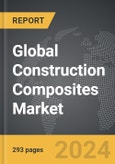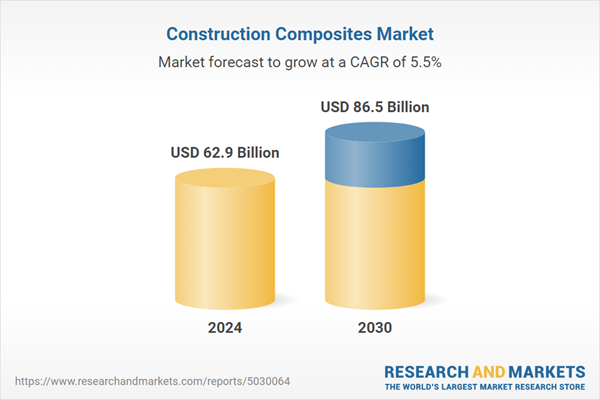The global market for Construction Composites was valued at US$62.9 Billion in 2024 and is projected to reach US$86.5 Billion by 2030, growing at a CAGR of 5.5% from 2024 to 2030. This comprehensive report provides an in-depth analysis of market trends, drivers, and forecasts, helping you make informed business decisions. The report includes the most recent global tariff developments and how they impact the Construction Composites market.
Segments: Product Type (Fiberglass, Metal Composites, Composite Wood, Other Product Types); End-Use (Industrial, Commercial, Residential, Other End-Uses).
Geographic Regions/Countries: World; United States; Canada; Japan; China; Europe (France; Germany; Italy; United Kingdom; Spain; Russia; and Rest of Europe); Asia-Pacific (Australia; India; South Korea; and Rest of Asia-Pacific); Latin America (Argentina; Brazil; Mexico; and Rest of Latin America); Middle East (Iran; Israel; Saudi Arabia; United Arab Emirates; and Rest of Middle East); and Africa.
The analysts continuously track trade developments worldwide, drawing insights from leading global economists and over 200 industry and policy institutions, including think tanks, trade organizations, and national economic advisory bodies. This intelligence is integrated into forecasting models to provide timely, data-driven analysis of emerging risks and opportunities.
Global Construction Composites Market - Key Trends and Drivers Summarized
How Are Construction Composites Revolutionizing Modern Building Materials?
Construction composites, which combine two or more distinct materials to create superior strength, durability, and versatility, are transforming the construction industry. These materials include fiber-reinforced polymers (FRP), wood-plastic composites, and reinforced concrete, all of which offer unique benefits compared to traditional building materials like steel or wood. Construction composites are widely used in infrastructure projects, such as bridges, highways, and buildings, due to their excellent strength-to-weight ratio, corrosion resistance, and adaptability. For instance, FRP composites, made from fibers like carbon or glass, are increasingly being used to reinforce concrete structures, providing enhanced durability and reducing the need for frequent repairs. Composites also allow for greater design flexibility, making them ideal for complex architectural projects. As the construction industry evolves, the demand for high-performance materials that improve structural integrity while reducing costs and environmental impact is driving the widespread adoption of construction composites.How Are Sustainability Trends Shaping the Demand for Construction Composites?
Sustainability is a key driver of innovation in the construction industry, and it is significantly influencing the demand for construction composites. As environmental regulations become stricter and consumers demand greener building practices, the use of sustainable materials has become a top priority. Construction composites, particularly those made from recycled or bio-based materials, are helping reduce the environmental footprint of construction projects. For example, wood-plastic composites (WPCs), which are made from a combination of recycled wood fibers and plastic, provide a sustainable alternative to traditional wood products. These materials offer the durability of plastic and the aesthetic appeal of wood, while also reducing deforestation and plastic waste. Additionally, composites like FRP have longer lifespans and lower maintenance requirements than traditional materials like steel, making them more sustainable over the long term. The ability to incorporate recycled materials into composite production is also reducing the environmental impact of resource extraction and manufacturing. As the construction industry continues to prioritize sustainability, the demand for eco-friendly construction composites is growing rapidly, reshaping the market.What Role Do Technological Advancements Play in the Development of Construction Composites?
Technological advancements are crucial in driving innovation in construction composites, improving their performance, sustainability, and cost-effectiveness. Research and development in composite materials are focused on enhancing their mechanical properties, such as strength, flexibility, and resistance to environmental factors like moisture, UV radiation, and chemical exposure. The development of advanced fiber-reinforced polymers (FRPs), for example, has enabled the creation of lighter, stronger, and more durable materials for use in construction, replacing heavier traditional materials like concrete and steel. Additive manufacturing (3D printing) is also revolutionizing the production of construction composites by allowing for more complex designs and customization. This technology enables manufacturers to produce composite structures with greater precision and less material waste, leading to cost savings and improved environmental efficiency. Furthermore, innovations in nano-materials and coatings are enhancing the functionality of composites, such as making them more fire-resistant, UV-stable, and resistant to water infiltration. As technology continues to advance, the range of applications for construction composites is expanding, making them more integral to modern construction projects.What Are the Key Growth Drivers of the Construction Composites Market?
The growth in the construction composites market is driven by several key factors related to technological advancements, increasing infrastructure development, and a growing focus on sustainability. One of the primary drivers is the rising demand for lightweight, durable, and corrosion-resistant materials that can enhance the lifespan of infrastructure projects while reducing maintenance costs. With governments and private sectors investing heavily in new infrastructure developments, particularly in emerging markets, the need for high-performance materials like fiber-reinforced polymers (FRPs) and wood-plastic composites (WPCs) is rapidly increasing. Composites are being widely adopted in the construction of bridges, buildings, and highways, where their ability to withstand harsh environmental conditions and reduce long-term maintenance costs is highly valued. Another significant driver is the emphasis on sustainability, as construction companies increasingly seek out materials that align with environmental regulations and green building certifications. Construction composites made from recycled or bio-based materials provide a sustainable alternative to traditional materials, helping reduce waste, carbon emissions, and reliance on non-renewable resources. Additionally, the increased focus on energy-efficient construction is spurring the use of composites, as they contribute to better insulation and reduced energy consumption in buildings. Technological advancements, such as 3D printing and the development of high-performance fiber composites, are further boosting market growth by enabling the production of more versatile, durable, and cost-effective materials. As the construction industry continues to evolve, the increasing use of composites in infrastructure, sustainability initiatives, and technological innovation are collectively driving the rapid expansion of the construction composites market, positioning it as a vital element in the future of building materials.Report Scope
The report analyzes the Construction Composites market, presented in terms of units. The analysis covers the key segments and geographic regions outlined below.Segments: Product Type (Fiberglass, Metal Composites, Composite Wood, Other Product Types); End-Use (Industrial, Commercial, Residential, Other End-Uses).
Geographic Regions/Countries: World; United States; Canada; Japan; China; Europe (France; Germany; Italy; United Kingdom; Spain; Russia; and Rest of Europe); Asia-Pacific (Australia; India; South Korea; and Rest of Asia-Pacific); Latin America (Argentina; Brazil; Mexico; and Rest of Latin America); Middle East (Iran; Israel; Saudi Arabia; United Arab Emirates; and Rest of Middle East); and Africa.
Key Insights:
- Market Growth: Understand the significant growth trajectory of the Fiberglass segment, which is expected to reach US$37.4 Billion by 2030 with a CAGR of a 5.6%. The Metal Composites segment is also set to grow at 6.6% CAGR over the analysis period.
- Regional Analysis: Gain insights into the U.S. market, valued at $16.3 Billion in 2024, and China, forecasted to grow at an impressive 8.6% CAGR to reach $20.1 Billion by 2030. Discover growth trends in other key regions, including Japan, Canada, Germany, and the Asia-Pacific.
Why You Should Buy This Report:
- Detailed Market Analysis: Access a thorough analysis of the Global Construction Composites Market, covering all major geographic regions and market segments.
- Competitive Insights: Get an overview of the competitive landscape, including the market presence of major players across different geographies.
- Future Trends and Drivers: Understand the key trends and drivers shaping the future of the Global Construction Composites Market.
- Actionable Insights: Benefit from actionable insights that can help you identify new revenue opportunities and make strategic business decisions.
Key Questions Answered:
- How is the Global Construction Composites Market expected to evolve by 2030?
- What are the main drivers and restraints affecting the market?
- Which market segments will grow the most over the forecast period?
- How will market shares for different regions and segments change by 2030?
- Who are the leading players in the market, and what are their prospects?
Report Features:
- Comprehensive Market Data: Independent analysis of annual sales and market forecasts in US$ Million from 2024 to 2030.
- In-Depth Regional Analysis: Detailed insights into key markets, including the U.S., China, Japan, Canada, Europe, Asia-Pacific, Latin America, Middle East, and Africa.
- Company Profiles: Coverage of players such as Advanced Environmental Recycling Technologies, Inc., Bedford Reinforced Plastics, CPG International, Diversified Structural Composites, Exel Composites Oyj and more.
- Complimentary Updates: Receive free report updates for one year to keep you informed of the latest market developments.
Some of the 44 companies featured in this Construction Composites market report include:
- Advanced Environmental Recycling Technologies, Inc.
- Bedford Reinforced Plastics
- CPG International
- Diversified Structural Composites
- Exel Composites Oyj
- Fibergrate Composite Structures Inc.
- Fiberon LLC
- Fibrolux GmbH
- Jiangsu Jiuding New Materials Co., Ltd.
- STRONGWELL Corporation
- TAMKO Building Products, Inc.
- TimberTech Limited
- Trex Co., Inc.
- UPM
- Zhengzhou Yalong Pultrex Composite Materials Co., Ltd.
Tariff Impact Analysis: Key Insights for 2025
Global tariff negotiations across 180+ countries are reshaping supply chains, costs, and competitiveness. This report reflects the latest developments as of April 2025 and incorporates forward-looking insights into the market outlook.The analysts continuously track trade developments worldwide, drawing insights from leading global economists and over 200 industry and policy institutions, including think tanks, trade organizations, and national economic advisory bodies. This intelligence is integrated into forecasting models to provide timely, data-driven analysis of emerging risks and opportunities.
What’s Included in This Edition:
- Tariff-adjusted market forecasts by region and segment
- Analysis of cost and supply chain implications by sourcing and trade exposure
- Strategic insights into geographic shifts
Buyers receive a free July 2025 update with:
- Finalized tariff impacts and new trade agreement effects
- Updated projections reflecting global sourcing and cost shifts
- Expanded country-specific coverage across the industry
Table of Contents
I. METHODOLOGYII. EXECUTIVE SUMMARY2. FOCUS ON SELECT PLAYERSIII. MARKET ANALYSISSOUTH KOREAREST OF ASIA-PACIFICARGENTINABRAZILMEXICOREST OF LATIN AMERICAIRANISRAELSAUDI ARABIAUNITED ARAB EMIRATESREST OF MIDDLE EASTIV. COMPETITION
1. MARKET OVERVIEW
3. MARKET TRENDS & DRIVERS
4. GLOBAL MARKET PERSPECTIVE
UNITED STATES
CANADA
JAPAN
CHINA
EUROPE
FRANCE
GERMANY
ITALY
UNITED KINGDOM
SPAIN
RUSSIA
REST OF EUROPE
ASIA-PACIFIC
AUSTRALIA
INDIA
LATIN AMERICA
MIDDLE EAST
AFRICA
Companies Mentioned (Partial List)
A selection of companies mentioned in this report includes, but is not limited to:
- Advanced Environmental Recycling Technologies, Inc.
- Bedford Reinforced Plastics
- CPG International
- Diversified Structural Composites
- Exel Composites Oyj
- Fibergrate Composite Structures Inc.
- Fiberon LLC
- Fibrolux GmbH
- Jiangsu Jiuding New Materials Co., Ltd.
- STRONGWELL Corporation
- TAMKO Building Products, Inc.
- TimberTech Limited
- Trex Co., Inc.
- UPM
- Zhengzhou Yalong Pultrex Composite Materials Co., Ltd.
Table Information
| Report Attribute | Details |
|---|---|
| No. of Pages | 293 |
| Published | April 2025 |
| Forecast Period | 2024 - 2030 |
| Estimated Market Value ( USD | $ 62.9 Billion |
| Forecasted Market Value ( USD | $ 86.5 Billion |
| Compound Annual Growth Rate | 5.5% |
| Regions Covered | Global |









